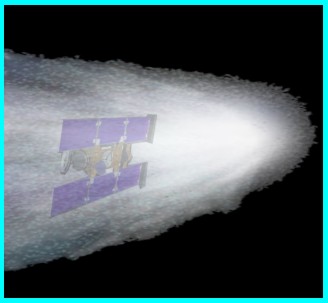
Comet Dust Has Hints of Organic Matter
By Irene Mona Klotz
Discovery News
Feb. 24, 2006—Specks of comet dust carried to Earth inside a NASA science probe show tantalizing hints of organic compounds, bolstering suspicions that comets delivered key ingredients for the development of life on Earth.By Irene Mona Klotz
Discovery News
Analysis of the samples brought back last month aboard the Stardust capsule is in the very early stages, but lead scientist Donald Brownlee said this week that he is encouraged by what researchers have found so far.
"We're seeing a variety of things that we know absolutely come from a comet," Brownlee, an astronomer with the University of Washington, said at the annual meeting of the American Association for the Advancement of Science.
Though analysis has just begun, the samples so far have revealed iron, sulfides, glassy materials and traces of olivine.
The samples are from Comet Wild-2, which flew just 149 miles (240 kilometers) past the Stardust spacecraft on Jan. 2, 2004.
During the encounter, the spacecraft extended a collection tray filled with 132 tiles of lightweight, heat-resistant gel that captured individual particles streaming off the comet's body.
As they bored into the gel, the particles created carrot-shaped trails, many of which were visible to the naked eye when scientists opened the canister upon its return to Earth a year later.
"When you have the samples in hand, it's a whole different universe," Brownlee said.
Early indications show Stardust collected at least 2,300 comet particles measuring 15 micrometers — one-third the diameter of a human hair — or larger, according to University of Chicago researchers who built one of the spacecraft science instruments.
Scientists are particularly keen to learn if any of the comet samples contain traces of matter from the original dust cloud that provided the raw materials for the creation of the solar system some 4.8 billion years ago.
Comets are believed to be relatively unchanged since their formation because they primarily dwell far from the sun's heat in a perpetual deep-freeze beyond Neptune's orbit.
After dropping off its return capsule for a parachute landing on Earth, the Stardust spacecraft was placed into a solar orbit while NASA weighs options for a second comet encounter. No more samples can be returned, but the probe has cameras and other instruments for close-up studies.
The first scientific results from the Stardust mission are expected to be released next month.
More . . .
See Also: NASA's Stardust Capsule To Put On Light Show
Home

No comments :
Post a Comment
Dear Contributor,
Your comments are greatly appreciated, and coveted; however, blatant mis-use of this site's bandwidth will not be tolerated (e.g., SPAM etc).
Additionally, healthy debate is invited; however, ad hominem and or vitriolic attacks will not be published, nor will "anonymous" criticisms. Please keep your arguments "to the issues" and present them with civility and proper decorum. -FW